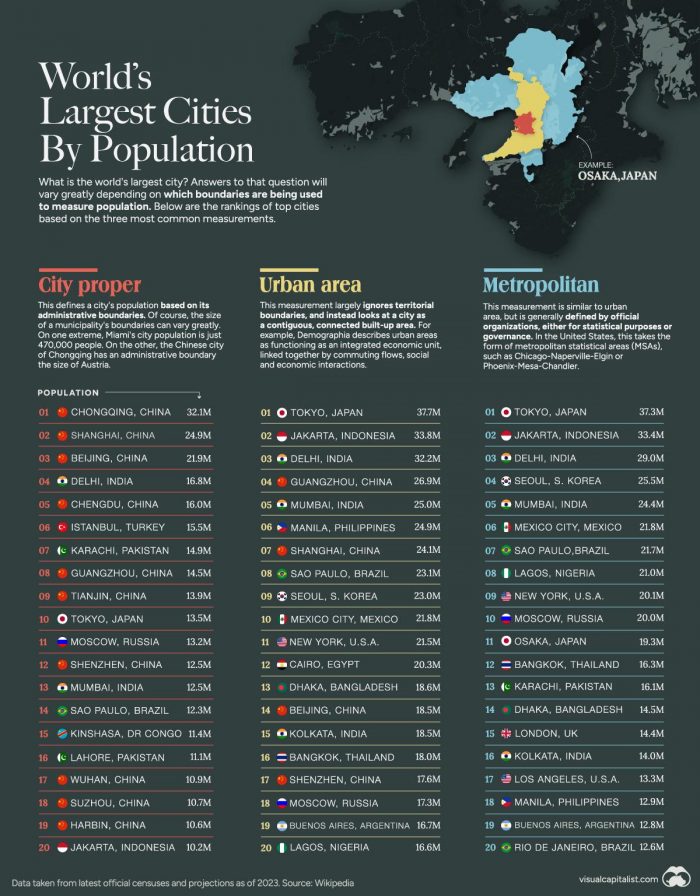
You won’t believe the size of some of these cities…
The Largest Cities in the World by Population
Chongqing, China – 32.1 million
Surpassing all other cities with a whopping population of 32.1 million, Chongqing is China’s secret powerhouse. It’s a major hub for manufacturing and transportation, with a growing focus on tech and innovation. The city’s motor vehicle production industry is particularly noteworthy; it’s like the Detroit of China!
Shanghai, China – 24.9 million
Home to almost 25 million people, Shanghai isn’t just a population heavyweight but also an economic titan. Known as the ‘Showpiece of the Booming Economy of Mainland China’, it’s a hotbed for industries like finance, tech, and world trade. In fact, it houses the world’s busiest container port.
Beijing, China – 21.9 million
As China’s capital city, Beijing’s 21.9 million residents contribute to a diverse range of sectors. The city is a cultural, political, and educational hub, with a significant focus on technology, especially telecommunications and information technology.
Delhi, India – 16.8 million
The bustling city of Delhi houses 16.8 million people and boasts a vibrant economy. It’s a major hub for IT services, telecommunications, and banking. Delhi’s textile industry and tourism sector also play a significant role in the city’s economy.
Chengdu, China – 16.0 million
With a population of 16 million, Chengdu is the economic engine of Western China. It’s a significant center for electronics, IT, and finance. Notably known for its panda research base, Chengdu’s tourism industry is also thriving.
The World’s Largest Urban Areas
Tokyo, Japan – 37.7 million
Topping the list of urban areas with its impressive 37.7 million residents, Tokyo is a global powerhouse. From electronics and automobiles to publishing, the city’s industries are as diverse as they are robust. Tokyo’s financial sector is particularly influential, housing the Tokyo Stock Exchange and numerous multinational corporations.
Jakarta, Indonesia – 33.8 million
Jakarta is not only Indonesia’s most populous city but also its economic, cultural, and political center. With a population of 33.8 million, this city’s economy revolves around manufacturing, service, trade, banking, and tourism.
Delhi, India – 32.2 million
Delhi makes a second appearance, this time with its urban population of 32.2 million. The city’s thriving urban areas are a hub for commerce, finance, and professional services.
Guangzhou, China – 26.9 million
With 26.9 million people, Guangzhou’s urban area is a hive of activity. The city is a significant global player in automotive manufacturing, petrochemicals, and electronics.
Mumbai, India – 25.0 million
Mumbai’s urban area houses 25 million people and is India’s financial, commercial, and entertainment capital. From Bollywood to the Bombay Stock Exchange, the city offers a diverse economic landscape.
The Largest Metropolitan Areas
Tokyo, Japan – 37.3 million
Tokyo makes a re-entry on our list, this time with its metropolitan area’s population of 37.3 million. This sprawling metropolis is an intricate web of diverse industries, making it a global economic powerhouse.
Jakarta, Indonesia – 29.0 million
With its metropolitan population of 29 million, Jakarta maintains its economic and cultural significance. Its metropolitan area is a bustling hub of commerce, housing various industries, from banking to manufacturing.
Delhi, India – 29.0 million
Delhi’s metropolitan area, home to 29 million people, reinforces the city’s economic strength. It’s a major center for commerce and trade, with a thriving service sector.
Seoul, South Korea – 25.5 million
South Korea’s capital, Seoul, boasts a metropolitan population of 25.5 million. The city is a significant global player in technology, finance, and manufacturing, hosting numerous multinational corporations.
Mumbai, India – 24.4 million
With its metropolitan population of 24.4 million, Mumbai is an economic titan. It’s a hub for finance, entertainment, and commerce, contributing significantly to India’s economy.
The Fastest Growing and Declining Cities
In conclusion, it’s interesting to note that while some cities are experiencing rapid growth, others are facing a decline in population. For instance, cities like Lagos in Nigeria and Dhaka in Bangladesh are predicted to grow rapidly due to urbanization and job opportunities. On the other hand, cities like Detroit in the USA and St. Petersburg in Russia are experiencing a decline due to economic challenges or aging populations. It’s a fascinating world out there, isn’t it?
